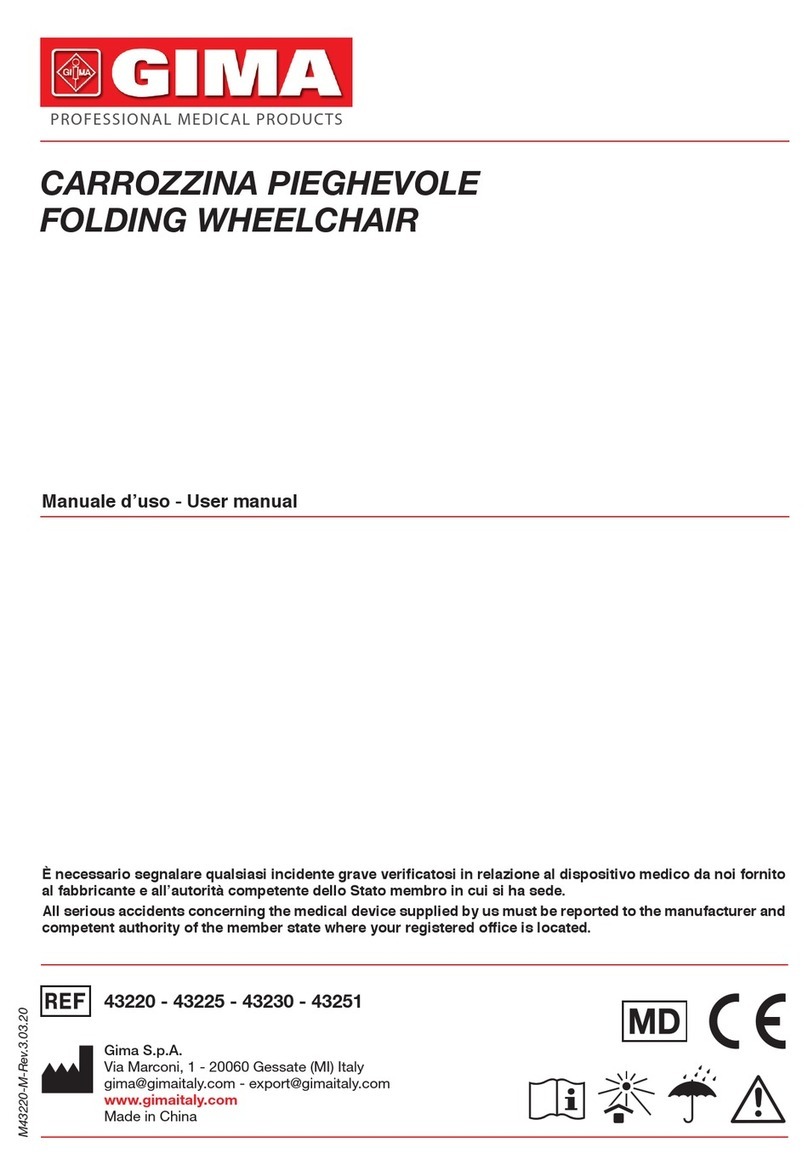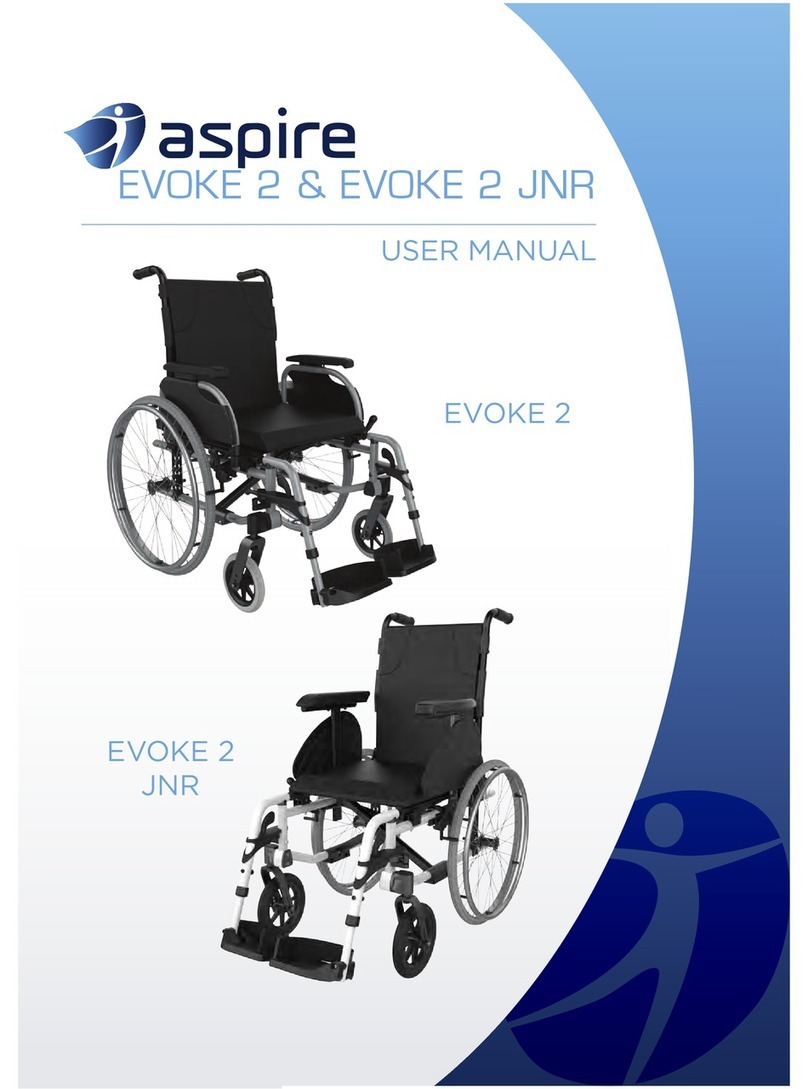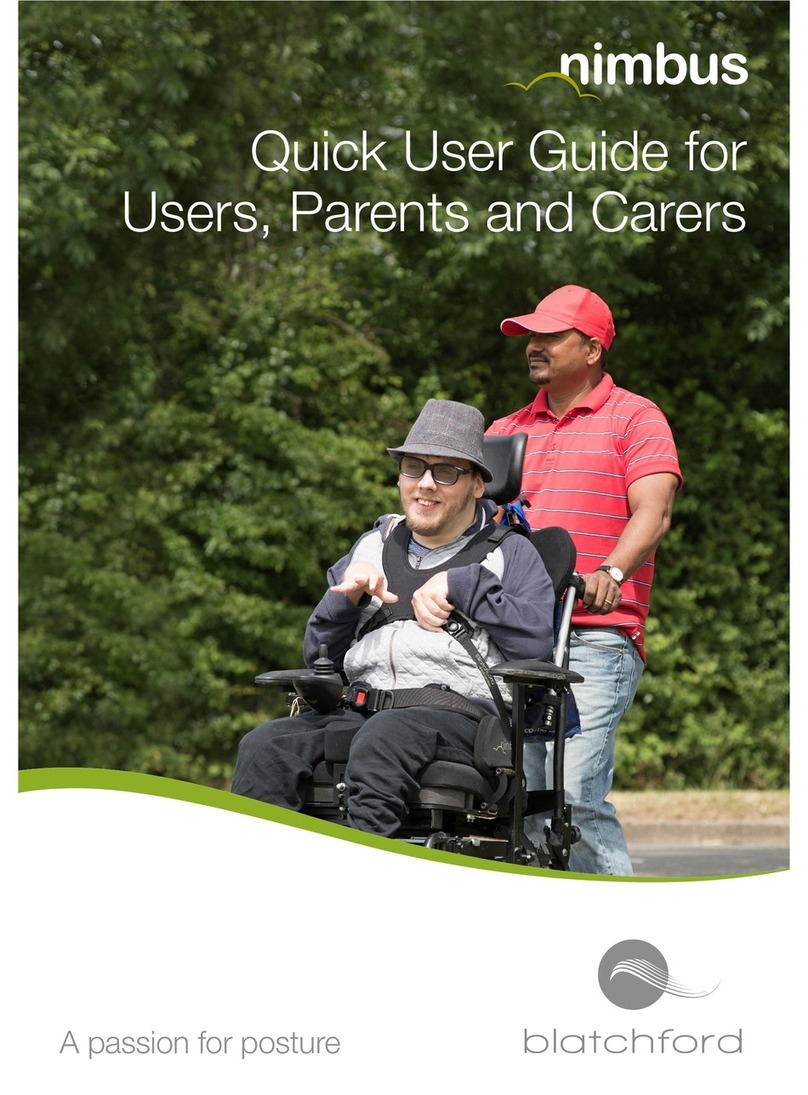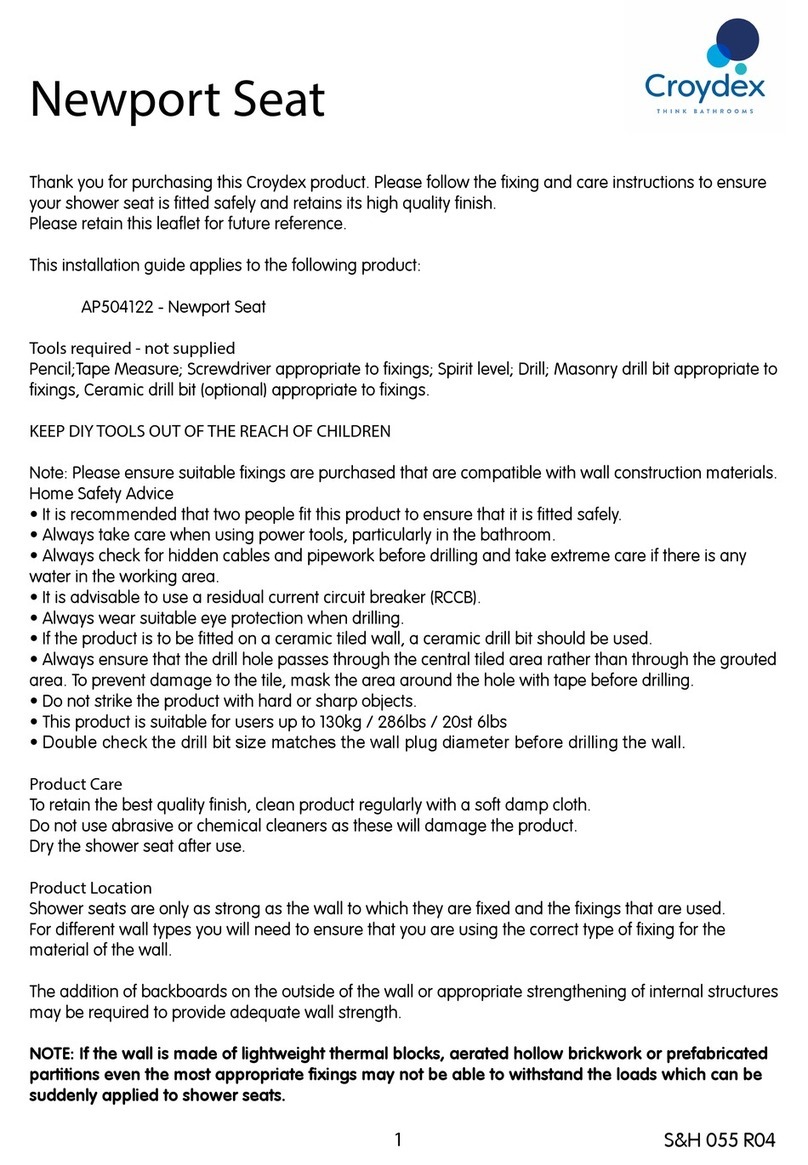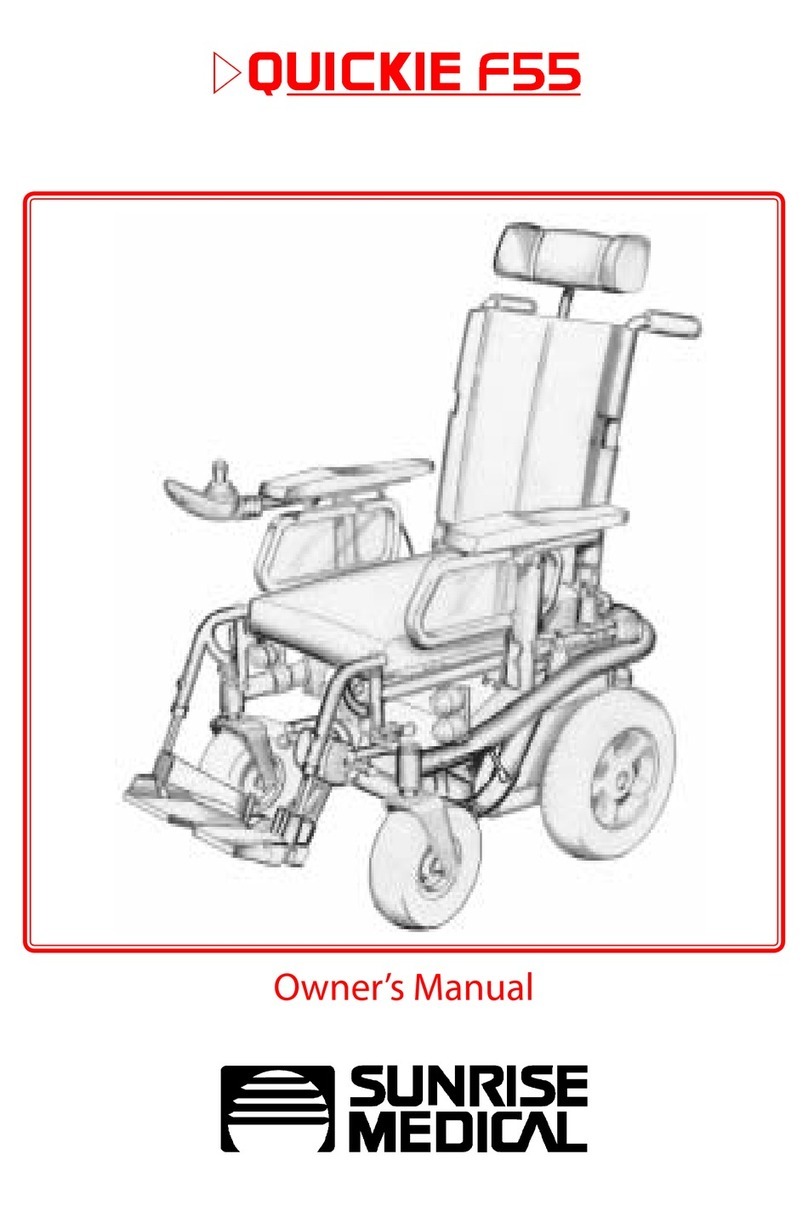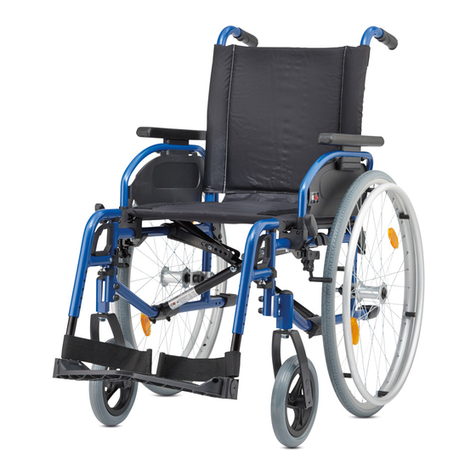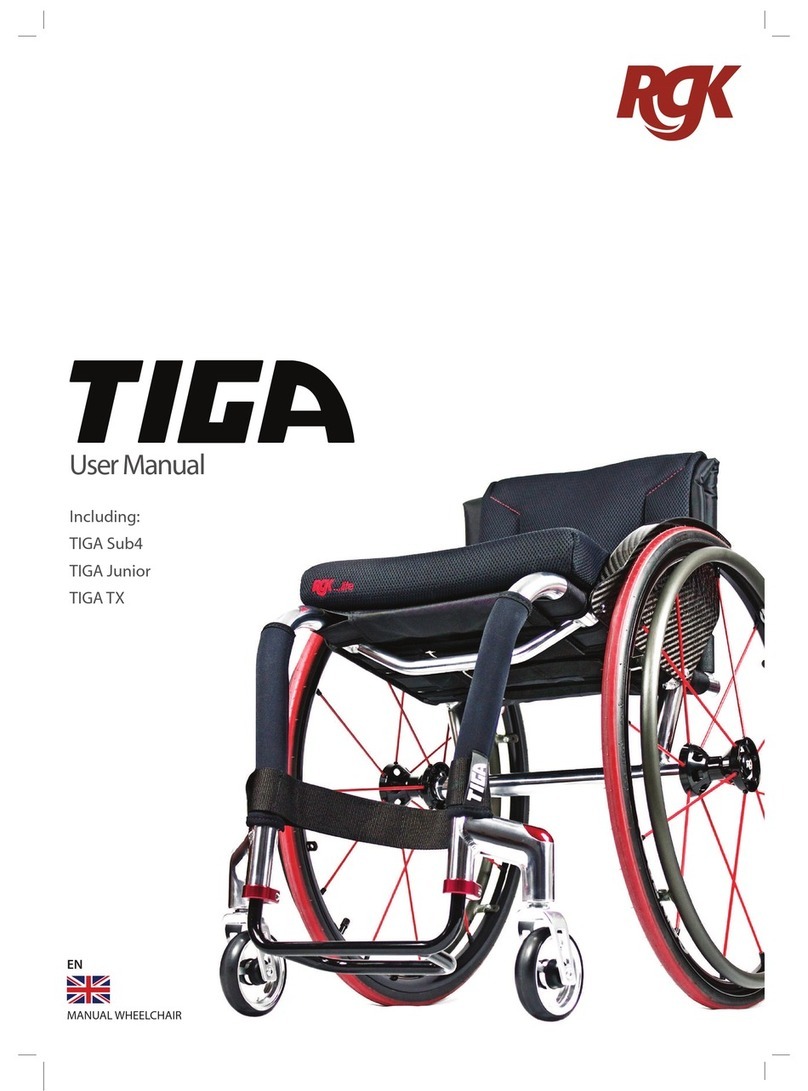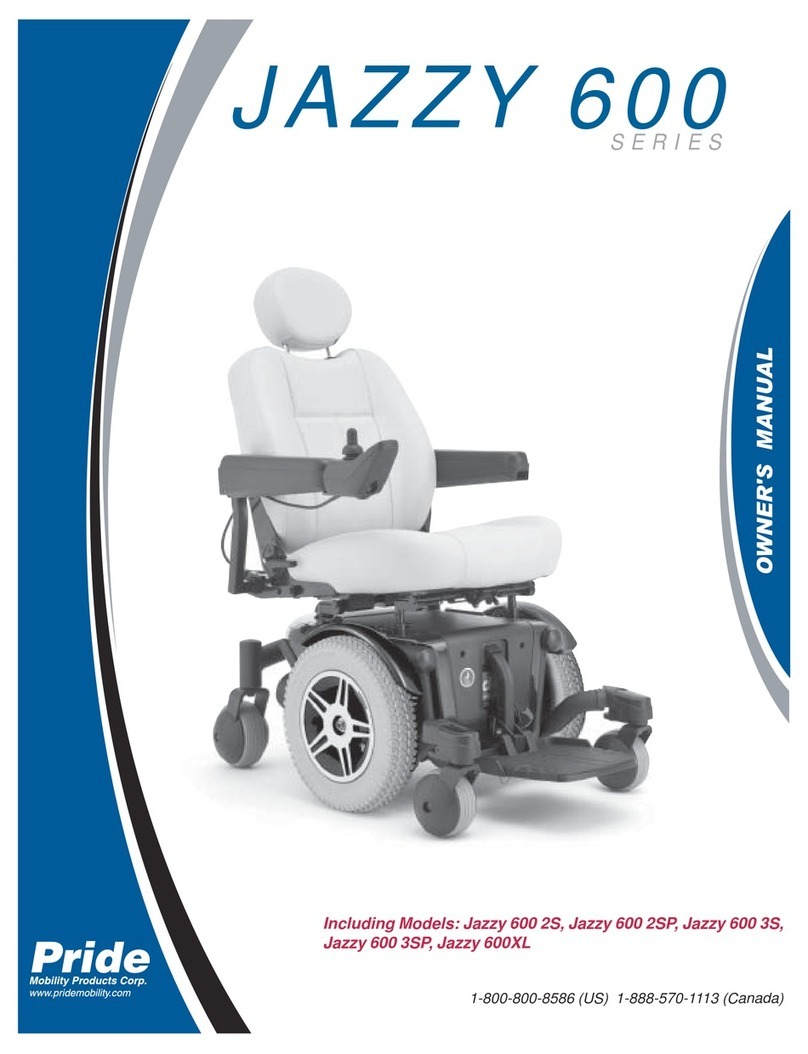SPEX constructa Instruction Manual

User Manual for all Spex Constructa Cushions (product code beins with ‘1102-’) Revision:
Spex Constructa Cushion_20240109_v2_EN
Installation & User Manual
User Name
Serial Number
IMPORTANT CONSUMER INFORMATION NOTICE:
This manual contains important instructions that must be passed on to the user of
this product. Please do not remove this user manual before delivery to the end user.
SUPPLIER: This manual must be given to the user of this product.
USER/CAREGIVER: Before using this product, read entire manual and save for future
reference. Transit Safety section MUST be read before product is used in a vehicle.
MD: This product is a Medical Device.

SPEX CONSTRUCTA USER MANUAL 2spexseating.com
Contents
Introduction 2
Intended Use 2
Safety Instructions 3
Weiht Capacity 3
Environment 3
Compatibility 3
Warnins 4
Cushion Contents 5
Re-issuin to Another User 5
Disposal and Recyclin 6
Get to Know your Foam Base 6
Adjust the Cushion 7
Base Adjustment 7
Constructa Flex Base Adjustment 8
Positionin Block and Contour Adjustment 9
Other Foam Adjustment Tips 11
Installin the Covers and Overlay 11
Fittin the Cushion 13
Maintenance and Cleanin 13
Assembly, Use, Maintenance and Limitations 14
Transit Safety 15
Warranty 19
Introduction
The Constructa rane of modular cushions was desined for a wide rane of symmetric and
asymmetric postures. With options for all aes and caterin to everythin from simple seatin
requirements to the most challenin demands, it’s our most anatomically adaptable cushion ever –
and the foundation for a safer, more comfortable experience for every individual user.
Check none of the parts are damaed from shippin. Contact Spex or your supplier for further
instructions if needed. Spex recommends that a clinician who is skilled in wheelchair seatin should
decide if the Constructa Cushion is appropriate for the user. They could be an Occupational Therapist,
Physiotherapist, or other health professional with trainin in wheelchair seatin and positionin.
Intended Use
Spex Seatin is intended for users (disabled and/or discomforted) that require specific postural and
positionin support to provide comfort for body function in a sittin posture on wheelchairs for daily
activities and for transportation in vehicles. It is desined with adjustments to provide improved
personal body-posture conditions and/or to help prevent/reduce physical problems associated with
sedentary work or activities.

SPEX CONSTRUCTA USER MANUAL 3spexseating.com
Safety Instructions
To avoid injury, read, understand and follow all instructions and warnins in this manual before installin
and usin the Spex Constructa Cushion. There are hazards associated with the use of wheelchairs
and adaptive equipment. If you misuse your wheelchair or your cushion you can be seriously injured.
If your cushion ceases to function as intended, please consult your authorized Spex Seatin supplier
immediately before continuin to use. Any serious incident that has occurred in relation to this product
should be reported to Spex Ltd.
The Spex Constructa Cushion cover and foam meet the flammability requirements of California
Technical Bulletin 117 and ISO 16840-10:2021. In rare cases the fabrics used in this product may
cause skin irritation for people with sensitive skin. If you experience any reddenin or itchin of the
skin consult with your health care professional.
Disclaimer: Spex takes no responsibility as to the therapeutic eectiveness of our products. Our
claims relate to the ability of the products to provide safe and reliable positionin and seatin on the
equipment onto which they are installed.
Weiht Capacity
• 14”-16” width cushion maximum user weiht: 200 lbs. (90 k)
• 18”-20” width cushion maximum user weiht: 300 lbs. (136 k)
Environment
Caution: Avoid sharp objects or exposure to extreme heat or open flame. These could damae
your cushion.
Moisture: Always keep your cushion dry. If your cushion ets damp or wet, thorouhly wipe
with a dry cloth as soon as possible. Never use your cushion in a showerin or pool
facility. Moisture is a contributin factor in causin pressure ulcers. It can damae your
cushion and could potentially cause failure.
Temperature: The cushion should be at room temperature before sittin on it. Your cushion may
not function as intended when used at extreme temperatures. Do not leave the Cushion
outside overniht or at temperatures below 5°C/41°F.
Dirt: Small bits of dust, dirt and sand can damae your cushion. Reularly wash your cushion
cover to ensure no build-up occurs.
Compatibility
• The Spex Constructa Cushion has been desined to be compatible with most wheelchairs.
• The Spex Constructa Cushion must have a solid base to install to, such as a solid seat base
or cushion riidizer, which provides more stability to the user.

SPEX CONSTRUCTA USER MANUAL 4spexseating.com
WARNING
RISK OF ACCIDENT, INJURY, PAIN OR DEATH IF WARNINGS ARE NOT FOLLOWED
Ask for help if you are unsure about any of the following points.
1. Check your skin for red marks or pressure spots regularly. If your skin is red
or itchy, stop using the cushion and consult with your healthcare professional.
2. Never use the cushion without the Overlay foam. Failure to do so may result
in pressure injuries.
3. Never use the cushion without a cover. Stay away from open flames or burning
cigarettes. Using the cushion without a cover increases the risk of flammability and
skin damage.
4. Never exceed the weight limit of your cushion or your wheelchair. The weight limit
of the wheelchair is specified by the wheelchair manufacturer. Never perform
exercise weight training that could exceed the weight limit of the wheelchair.
5. Check if anti-tippers or other adaptations need to be added to the wheelchair to
help increase stability. Installing seating systems may aect the centre of gravity
and could cause the wheelchair to tip.
6. The Spex Constructa Cushion has been designed as a cushion for wheelchair
users. Never use your cushion in ways it is not designed to be used.
7. Adjusting the cushion can change the pressure distribution. Only clinicians who
are skilled in wheelchair seating should adjust the cushion. They could be an
Occupational Therapist, Physiotherapist, or other health professional with training in
wheelchair seating and positioning. Adjustment should follow a proper assessment
of the user’s needs.

SPEX CONSTRUCTA USER MANUAL 5spexseating.com
Outer Cover
Overlay
Front
Inner Cover
Positionin
Base
Adjustment
Kit (optional)
Cushion Contents
Your cushion contains the following:
Re-issuin to Another User
Once the user has finished using the Constructa Cushion, it must be refurbished and thoroughly
cleaned if it is issued to another user. Below are the strict guidelines for refurbishing the Constructa
Cushion. Spex takes no responsibility for contamination, cross infection, or damage. Spex recommends
using AHP (Accelerated Hydrogen Peroxide) disinfectant wipes. The disinfection product must be
used as per the manufacturer instructions. Spex takes no responsibility for the eectiveness of the
disinfecting process.
Part Procedure
Safety check Check all parts for signs of collapse, water damage, UV damage, or rips.
Outer Cover Replace the outer cover regardless of its condition.
Overlay Replace the foam and cover regardless of their condition.
Inner Cover Check for water damage, UV damage, or rips.
Wipe the inner cover and follow the Maintenance and Cleaning instructions
for washing.
Base foam Make sure the base has:
• Base
• Positioning Blocks
• Contours
See the Cushion Contents and the Spare Part Ordering Guide (separate document) for accurate
details on what this contains.
Check that Velcro is securely attached to each part.
Check the foam for signs of collapse, water damage, UV damage, or rips.
Ischial Insert Replace the ischial insert regardless of its condition.

SPEX CONSTRUCTA USER MANUAL 6spexseating.com
Disposal and Recyclin
Many of the materials in your Spex Seating System can be recycled by taking it to a recycling centre.
Thank you for looking after the environment! Follow all local laws and regulations when disposing of
your Spex Seating System.
Get to Know your Base Foam
Detach the Overlay and remove the Inner
Cover to reveal the base foam.
Depending on the cushion (Shape or Flex),
your Base foam contains the following:
Description Quantity
AContours
A1 Lateral Pelvic Contour 2
A2 Lateral Thigh Contour 2
A3 Medial Thigh Contour 1
BIschial Insert 1
C Positioning Blocks
C1 Trochanter Block 2
C2 Pre-Ischial Shelf 1
C3 5cm Thigh Block 1
C4 Thigh Block 1
DBase 1
Description Quantity
AAContoursContours
A1A1 Lateral Pelvic ContourLateral Pelvic Contour 22
A2A2 Lateral Thigh ContourLateral Thigh Contour 22
A3A3 Medial Thigh ContourMedial Thigh Contour 22
BBIschial InsertIschial Insert 11
CCPositioning BlocksPositioning Blocks
C1C1 Trochanter BlockTrochanter Block 22
C2C2 Pre-Ischial ShelfPre-Ischial Shelf 22
C3C3 5cm Thigh Block5cm Thigh Block 22
C4C4 Thigh BlockThigh Block 22
DDBaseBase
D1D1 LegLeg 22
D2D2 Rear Underpanel PivotRear Underpanel Pivot 22
D3D3 Leg WedgeLeg Wedge 22
D4D4 Ischial PadIschial Pad 1212
A
B
C
D
A
D
B
C

SPEX CONSTRUCTA USER MANUAL 7spexseating.com
Adjust the Cushion
The Spex Constructa Cushion works for dierent
body positions in people with disabilities or sitting
challenges. By changing the base foam, the cushion
surface adjusts to help with overall posture, pelvic
alignment, sitting ability, comfort and pressure
distribution.
Always put the Overlay on top of the base foam before using the cushion, even when setting it up. The
Overlay helps reduce pressure and blend gaps in the base foam.
When setting up the cushion, it might be easier to make changes without the Inner Cover. During the
assessment process you can test the cushion adjustments by attaching the overlay to the top of the
positioning base. Use the front flaps to keep it in place.
Once the base foam is adjusted, fit the Inner Cover, attach the Overlay and fit the Outer Cover and
check the cushion function.
Caution:
• Ensure the Ischial Tuberosities are positioned on the ischial insert foam. If positioned incorrectly (on;
Trochanter Blocks, Contours, Pre-Ischial Shelf, Thih Blocks), this may result in pressure injuries.
• This Cushion must be trailed first to determine its eectiveness in meetin the needs of the user.
The clinician must inspect the user’s skin to ensure that red pressure spots are not developin.
Base Adjustment
The Strategic Positioning Kit allows you to add or remove
Pelvic and Thigh Positioning Pads to adjust the cushion for
dierent needs, such as:
• Correct or accommodate pelvic obliquity
• Support minor flexion limitations
• Ramp the cushion to provide anti-thrust
• Dump the cushion provide added stability
• Anle the cushion to aid puntin
The Constructa Flex base has more adjustments for users
with complex needs. If you have a Constructa Shape, you
can go to ‘Positioning Block and Contour Adjustment’.

SPEX CONSTRUCTA USER MANUAL 8spexseating.com
Constructa Flex Base Adjustment
Make adjustments to the base to change the shape of the cushion surface. Removing some of the
positioning blocks may make it easier to adjust. The base should be adjusted before the contours.
Images (for illustrative purposes only) Description of Adjustment
Hip/Thigh Angle
Remove the Leg Wedge to lower the leg (open hip angle).
To increase the angle, reattach the wedge in reverse
(thinner edge to the front). This will be 15 degrees.
Wedges can be added to raise the thighs (reducing the
hip angle).
Pelvic Height
Adjust the pelvic height by adding or removing Ischial
Pads.
When the thigh angle is lowered to 15 degrees or more,
extra ischial pads must be added.
Internal and External Rotation
Rotate the Leg Wedge by 90 degrees.
The wedge may need to be trimmed to fit.
Pelvic Obliquity
Add or remove Ischial Pads.
To accommodate a pelvic obliquity, add pads to match
the posture.
To correct a pelvic obliquity, do the opposite.
Flip the pads when moving them between the left and
right sides.
Leg Length Discrepancy or Seat Depth
Leg length can be shortened by 1” using the puzzle joint.
Peel up the leg and reattach further back in the puzzle
joint.
To increase the discrepancy; extend the other leg as
much as possible.
For seat depth adjustment; do the same on the other leg.
To reset; position the legs with a 1” (25mm) gap in the
back of the puzzle joints.

SPEX CONSTRUCTA USER MANUAL 9spexseating.com
Images (for illustrative purposes only) Description of Adjustment
Abduction and Windsweeping
Adduct or abduct either one or both legs using the puzzle
joint adjustment. Peel up the leg and reattach at the
desired angle.
Pay attention to the leg length to ensure it is not too long
or short as this is also adjusted at the same time.
Positionin Block and Contour
Adjustment
These adjustments apply to both Shape and Flex cushions, the only dierence is the split between the
legs. The Constructa Flex cushion has pairs of: thigh block, pre-ischial shelf and medial contour pad.
We recommend making the Flex Base adjustments (see previous) before refining the Positioning
Blocks and Contour Pads.
Images (for illustrative purposes only) Description of Adjustment
Pelvic Width
Move the Trochanter Blocks in or out to match the pelvis.
Done correctly this will load the greater trochanters and
ooad the ischial tuberosities (ITs).
Move the Lateral Pelvic Contours in or out to support
the pelvis and load the greater trochanters and hips
eectively.
Make sure the inner edge of the Lateral Pelvic Contour
does not sit over the Trochanter Block undercut as this
will increase pressure in the ischial well.
Seat Width
The Lateral Pelvic and Lateral Thigh Contours can be
adjusted in or out to support a narrower or wider user.
Make sure the pelvic width is adjusted correctly using
both the Trochanter Blocks and Lateral Pelvic Contours
(detailed above)
SuperHigh and Standard contours are designed for width
reduction only.
High contours can also be moved 1” wider if needed.

SPEX CONSTRUCTA USER MANUAL 10 spexseating.com
Images (for illustrative purposes only) Description of Adjustment
Seat Depth and Pelvic Positioning
Move or remove the 5cm Thigh Block to reduce the seat
depth (bringing the Pre-Ischial Shelf forwards). This is
also useful for supporting in posterior pelvic tilt.
Curve and form the Pre-Ischial Shelf to support the
pelvis eectively.
Abduction and Windsweeping
Lateral Thigh and Medial Thigh Contours can be moved
to accommodate for abduction, wind sweeping, internal
and external rotation.
Pelvic rotation
For pelvic rotation; the 5cm Thigh Block can be removed
or cut in half to allow the Pre-Ischial Shelf to be moved
further forward on one side.
To correct a flexible rotation, build up the shelf as
detailed below, ‘Anti-Thrust Support’
Thigh contours can also be positioned to accommodate
rotation.
Anti-Thrust Support
Add Thigh Positioning Pads under the base to build up
the front of the cushion.
For an abrupt shelf, add them between the Thigh Blocks
and the Base.
To further block the ITs and restrict forward migration,
remove the Pre-Ischial Shelf and position the 50mm
Thigh Block in its place.

SPEX CONSTRUCTA USER MANUAL 11 spexseating.com
Other Foam Adjustment Tips
Adjustments must be based on biomechanical evaluation and assessment.
• Trochanter Block position is important to support the pelvis and maximise pelvic ooading.
• Thigh Blocks and Trochanter Blocks can be inverted to increase support and reduce immersion
in some areas.
• Gaps between the base foam components are acceptable, but ensure the Overlay is positioned
correctly before fitting the Outer Cover. The Overlay is needed for pressure management and
blending the contours of the cushion.
• To correct an anterior pelvic tilt: Leave the base foam flat or slightly raise the front of the base foam
for neutral alignment of the pelvis or promoting weight bearing on ischial tuberosities.
• Positioning Blocks, Contours, and Bases can be cut to expand the adjustment range – replacement
parts are available from our Constructa Cushion Spare Parts Script.
Caution:
Only use genuine Spex covers, accessories, and components with your cushion.
Installin the Covers and Overlay
Once the base foam is adjusted, fit the Inner Cover. This is a loose fit to allow for adjustment to the
base foam.
Caution:
• Never use the cushion without the Inner Cover. Failure to do so will reduce the life of the cushion.
• Overlay foam must be used with the Overlay cover, with the flaps and the straps attached. Failure
to do so will allow the overlay to move and may cause pressure injuries over time.

SPEX CONSTRUCTA USER MANUAL 12 spexseating.com
1. Place the Overlay on top of the cushion and line up
the front edge with the front edge of the Inner Cover.
2. Press the Overlay into the leg troughs to match the
cushion profile. Pull the Front Flaps tight and attach
under the base.
Make sure the Overlay is centred on the cushion.
Flex only: Attach the inner leg straps firmly under the
cushion. Make sure the Medial Contours are covered
by the Overlay and the Overlay is aligned with the inner
edge of the cushion.
3. Loop the 4 side straps from the Inner Cover up and out
through the Overlay loops. Fold the strap back down
and attach to itself. Set the tension so the overlay is
held in place but not too tight.
Caution:
Overlay side straps must not be too tight. This could
cause the Overlay to hammock and reduce the pressure
management of the cushion.
4. Attach the rear flap under the cushion to stop the Overlay
from sliding forward. This flap does not need to be tight.

SPEX CONSTRUCTA USER MANUAL 13 spexseating.com
Fittin the Cushion
1. Position the cushion about 1cm forward
of the front edge of the seat base to
protect the user’s legs.
Constructa labels on the sides of the
Outer Cover show the front of the
cushion. The front of the cushion must
always face forwards.
• Handle is at the front
of the Constructa Shape
• Handle is at the back
of the Constructa Flex
2. Check the size of the cushion. The cushion must fully support the base of the user. If the
cushion is too long it may force the user to sit with a posterior pelvic tilt.
3. Proper foot position may enhance sitting comfort. Adjust the foot supports so the user’s legs
are supported by the cushion and the foot supports.
Maintenance and Cleanin
Monthly cleaning and regular maintenance will help extend the life of the cushion. The expected
lifetime of the cushion is 5 years; however, the cushion needs to be checked regularly for
performance.
Spex recommends using AHP (Accelerated Hydrogen Peroxide) disinfectant wipes. The disinfection
product must be used as per the manufacturer instructions. Spex takes no responsibility for the
eectiveness of the disinfecting process.
Caution:
• Replace the cover correctly after washing. Check the back of the cover matches up to the back
of the foam base.
• Use only Spex Constructa Covers on Spex Constructa Cushions. Changing the Outer Cover,
or using dierent materials, will alter the cushion performance.
Foam
• Keep dry.
• Check the foam base regularly to ensure good foam consistency.
• If it accidentally becomes wet, dry thoroughly before replacing the covers.

SPEX CONSTRUCTA USER MANUAL 14 spexseating.com
Outer Cover
• Remove the cover from the foam base and turn inside out.
• Machine wash in warm water (40°C / 104⁰F)
• Drip or tumble dry on low heat.
• Do not iron. Do not dry clean. Do not bleach.
• If chemical cleaners are used, covers must be rinsed thoroughly with water to remove all chemical
residue and left to dry completely before reuse.
• Check the cover for tears and excessive wear and replace it if ripped, torn or otherwise not fully
functional.
• If used in an institutional setting, write the resident’s name with a permanent marker on the content
label of the covers. This will help to ensure the return of the covers after washing.
If you have any additional questions regarding cleaning procedures, please contact your authorised
Spex Seating dealer.
Assembly, Use, Maintenance
and Limitations
• Adjustments to the set-up of the wheelchair must only be carried out by a qualified therapist,
professional, or seating technician. Custom contoured/bespoke systems may require a qualified
professional to configure and install the seating system.
• After carrying out any adjustments ensure all bolts, screws and nuts are securely fastened again to
ensure safety when travelling in a vehicle.
• Ensure the top and bottom mounts of the backrest and the front and rear mounts of the seat pan
are installed as far apart from each other as possible to give a stronger 4-point attachment to the
wheelchair frame. Ensure the quick release latches are engaged.
• Do not use the Spex Seating System as a vehicle seat if seating components which have not been
successfully crash tested are used anywhere on the seating system. Spex seating is designed and
certified using only Spex components. Spex is not liable in the event where other manufactured
seating systems are used in conjunction with Spex seating.
• At regular intervals check that all the fastenings on the Spex Seating System have not become
loose during day to day use and re-tighten if necessary.
• Ensure the swing-away laterals are in their locked position before using the seat as a vehicle seat
in a motor vehicle.

SPEX CONSTRUCTA USER MANUAL 15 spexseating.com
Transit Safety
The Spex Seating System has been successfully crash tested and complies with RESNA WC-4:2017,
Section 20 (WC20). The Spex Seating System meets the requirements of ISO 16840-4:2009 and is
suitable for use as a motor vehicle seat when used with an appropriate wheelchair base. Please follow
all installation, use and maintenance instructions within this manual as well as the following transit
instructions. If feasible, the wheelchair user should transfer to the vehicle seat and use the vehicle-
installed occupant restraint systems.
Spex Seating System has been designed to accommodate the proper use of vehicle-anchored belt
restraints. Spex achieved a rating of Excellent (16 out of 16), for ease of properly positioning a belt
restraint, and the degree to which proper belt restraint can be achieved, based on the methods of
Annex D. The following items of the Spex Seating System have been tested and are suitable for use
in a motor vehicle:
• Full Height Back Support Models
• Seat Base
• Cushion Models
• Arm and Thigh Supports
• Trunk Lateral Supports
• Head Supports
Note: Back supports that are lower than the user’s shoulder height are not certified and not
recommended for transport in a vehicle. Eg. Zygo Lo back supports.

SPEX CONSTRUCTA USER MANUAL 16 spexseating.com
Correct Positioning of Belt Restraints
When using the Spex Seating System as a vehicle seat, both a
pelvic- belt restraint and shoulder-belt restraint must always be
used. To correctly position the belt restraints on the wheelchair
occupant, the following must be ensured:
• The pelvic-belt restraint should be worn low across the front of
the pelvis near the junctions of the pelvis and thighs.
• The angle of the pelvic-belt restraint should be between 30° to
75° relative to the horizontal and, ideally, between 45° to 75° to
the horizontal (as shown in Figure 2).
• The belt-restraint buckle of three-point belt restraints should
be placed in contact with the occupant’s body and away from
wheelchair components.
• The junction of the shoulder-belt and pelvic-belt of three-
point- belt restraints should be located near the hip opposite
the shoulder over which the diagonal belt crosses and not near
the midline of the occupant.
• Belt restraints should not be routed outside of the wheelchair
wheels or over the wheelchair armrests, and should not be held
away from the body by wheelchair components or parts.
• Upper torso belt restraints should fit directly over, and in contact with, the middle of the shoulder.
• Belt restraints should be adjusted to fit as snugly as possible, consistent with user comfort.
• Belt restraints should not be worn twisted in a manner that reduces the area of contact of the belt
webbing with the occupant.
Figure 1
Figure 2
Pelvic belt restraints should make good
contact with the front and sides of the
body near the junctions of the thighs
and pelvis and against the hips.
Belt restraints
must not be held
away from the
body by wheelchair
components such
as armrests or
wheels.
Figure 3b - Proper routing and positioning of
belt restraints on the wheelchair occupant.
Figure 3a - Improper positioning of pelvic-
belt restraints over wheelchair supports.

SPEX CONSTRUCTA USER MANUAL 17 spexseating.com
WARNING
1. The distance between the top of the user’s shoulder and the top of the back should not exceed
6.5” (16.5 cm).
2. The Spex Seating System must only be used with wheelchair bases that are tested as part of a
wheelchair system that conforms to performance requirements of ISO 7176-19 and RESNA WC-
4:2017, Section 19.
3. The Spex Seating System should only be used on wheelchair frames that provide four securement
points and pelvic-belt anchor points that conform to the requirements of RESNA WC-4: 2017,
Section 19.
4. The wheelchair must be labelled as appropriate for use as a seat in a motor vehicle, dynamically
tested to the performance requirements of ISO 7176-19 and installed, used and maintained
according to the manufacturer’s instructions.
5. The Spex Seating System must only be used as indicated in this user manual.
6. Both pelvic and shoulder-belt restraints as a part of a complete Wheelchair Tie down and Occupant
Restraint System (WTORS) which meets ISO 10542-1 shall be used to achieve eective occupant
restraint and optimum protection in a vehicle impact; the belt restraints should be compatible
with the specific wheelchair, and fitted to the user in accordance with WTORS manufacturer’s
instructions.
7. Back supports with adjustable recline angles should not be tilted back more than 30° beyond
the vertical during travel in vehicles unless necessary for the medical and postural needs of the
occupant.
8. If the back support must be adjusted to an angle that is greater than 30° beyond the vertical
during travel, the upper shoulder-belt anchor point should be adjusted rearward to maintain belt
contact with the wheelchair occupant’s shoulder and chest.
9. The Spex Seating System must only be used for forward-facing seating in motor vehicles.
10. In order to reduce the potential of injury to vehicle occupants, wheelchair-mounted rigid trays not
specifically intended for use during travel in motor vehicles must be:
a. Removed and secured separately in the vehicle or
b. Secured to the wheelchair so they will not break free in a crash and
• Be positioned with a gap of at least 3” (75 mm) between the back edge of the tray and the
wheelchair occupant’s abdomen and/or chest so as not to interfere with the proper belt-
restraint use, and
• Have energy absorbing padding placed between the back edge of the tray and the
wheelchair occupant.
11. Alterations or substitutions must not be made to the seating system structure, parts or
components, without first consulting Spex.

SPEX CONSTRUCTA USER MANUAL 18 spexseating.com
12. The use of a postural pelvic belt attached to the wheelchair base or seat frame is encouraged
during travel, but these belts should be positioned so that they don’t interfere with the proper
positioning of crashworthy belt restraints, and they should not be relied on for occupant protection
in crash situations unless the postural belt has been designed to comply with, and perform to the
requirements of WC19.
13. Postural support devices that are not labelled as conforming to ISO 16840-4 may be used when
in a vehicle, but should not be relied on for occupant restraint.
14. Both pelvic-belt and shoulder-belt restraints that comply with WC18 and/or WC19 should be used
to limit occupant movement in a crash and reduce the likelihood of occupant ejection from the
vehicle and/or injurious contact of the occupant with the vehicle interior.
15. Belt restraints should be positioned on the wheelchair occupant in accordance with WTORS
manufacturer’s instructions.
16. Backrest mounting hardware must be installed correctly. Refer to the appropriate section for
correct backrest hardware mounting instructions.
17. If the wheelchair is being transported while occupied, the wheelchair must still be secured to the
WTORS.
18. Children whose mass is less than 48.5 lbs. (22 kg) should be transferred from their seating
system into appropriate child restraint systems intended for use in motor vehicles.
19. Sucient forward and rearward clear space should be provided around the wheelchair occupant.
Forward clear-space zone (FCZ) needs to be larger when a shoulder-belt restraint is not used.
FAILURE TO HEED THESE WARNINGS COULD CAUSE SEVERE INJURY TO THE
WHEELCHAIR USER OR OTHERS.
NOTES: The rear clear zone is measured from the
rearmost point on an occupant’s head. The front
clear zone is measured from the front most point
on an occupant’s head.
Seated head height (HHT) ranges from about
1200mm for a small adult female to about
1550mm for a tall adult male.
FCZ = 650mm (25.6”) with upper-torso restraint
= 950mm (37.4”) with only pelvic restraint
NOTES: It is strongly recommended that both
pelvic and upper-torso belts be used.
TOP VIEW
FCZRCZ
HHT
SIDE VIEW

SPEX CONSTRUCTA USER MANUAL 19 spexseating.com
Warranty
Every Constructa Cushion is carefully inspected to provide peak performance. We guarantee that your
Constructa Cushion will be free from defects in materials and workmanship for a period of 24 months
from the date of purchase, assuming normal use.
Should a defect in materials or workmanship occur within 24 months from the original date of
purchase, Spex will, at its discretion, provide a free repair or replacement. This warranty applies to all
cushion components including the Outer Cover, Overlay, Inner, and Positioning Kit.
Please note that this warranty does not cover general wear and tear, such as punctures, tears, burns,
or customer misuse of any cushion components.
Because of the modular design of the Constructa Cushion, minor deviations or imperfections in
its internal components may occur over time without compromising product performance. These
imperfections, which may arise from adjustments or use, fall outside the scope of warranties when
they do not impact the cushion's functionality.
Claims and repairs should be processed through the nearest authorized Spex supplier. Except for
express warranties made herein, all other warranties, including implied warranties of merchantability
and warranties of fitness for a particular purpose are excluded. There are no warranties which extend
beyond the description on the face hereof. Remedies for breach of express warranties herein are
limited to repair or replacement of the goods. In no event shall damages for breach of any warranty
include any consequential damages or exceed the cost of non-conforming goods sold.
The serial number of your Cushion can be located inside the Cushion cover.

SPEX CONSTRUCTA USER MANUAL 20 spexseating.com
Spex Ltd
Phone +64 3 307 9790
solutions@spexseating.com
spexseating.com
32 Detroit Drive
Rolleston 7675
New Zealand EC REP
BEO MedConsulting Berlin GmbH
Helmholtzstr. 2
D-10587 Berlin, Germany
Tel: +49-30-318045-30
US REP
Medicept
200 Homer Ave, Ashland, MA 01721
United States
Tel: +1-508-231-8842
Table of contents
Other SPEX Wheelchair manuals
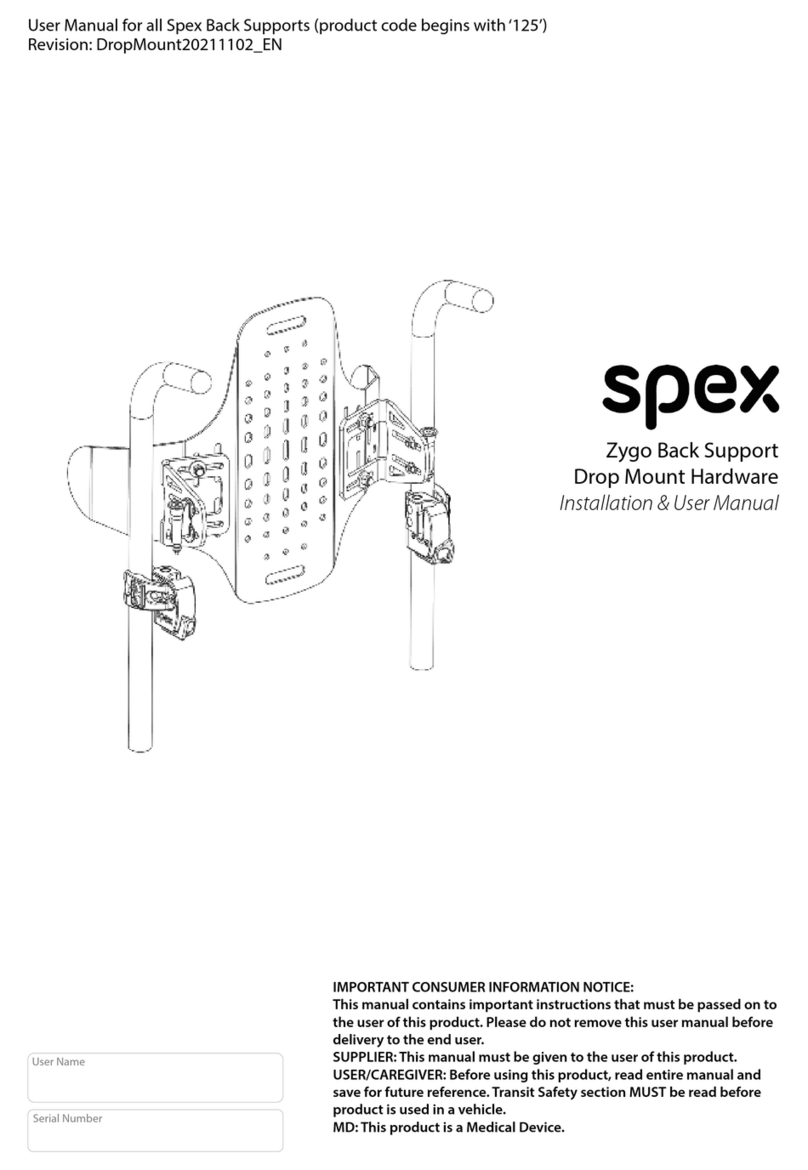
SPEX
SPEX Zygo Back Support Instruction Manual

SPEX
SPEX Arm & Thigh Supports Instruction Manual
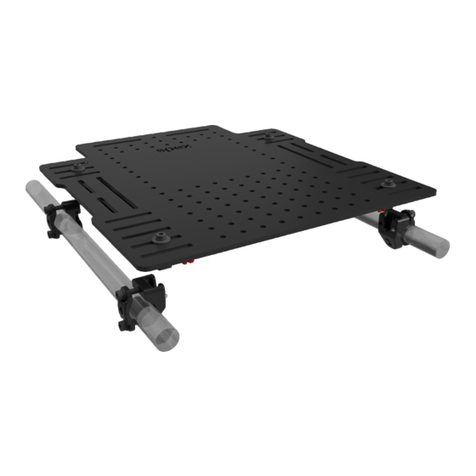
SPEX
SPEX 1008 Series User manual
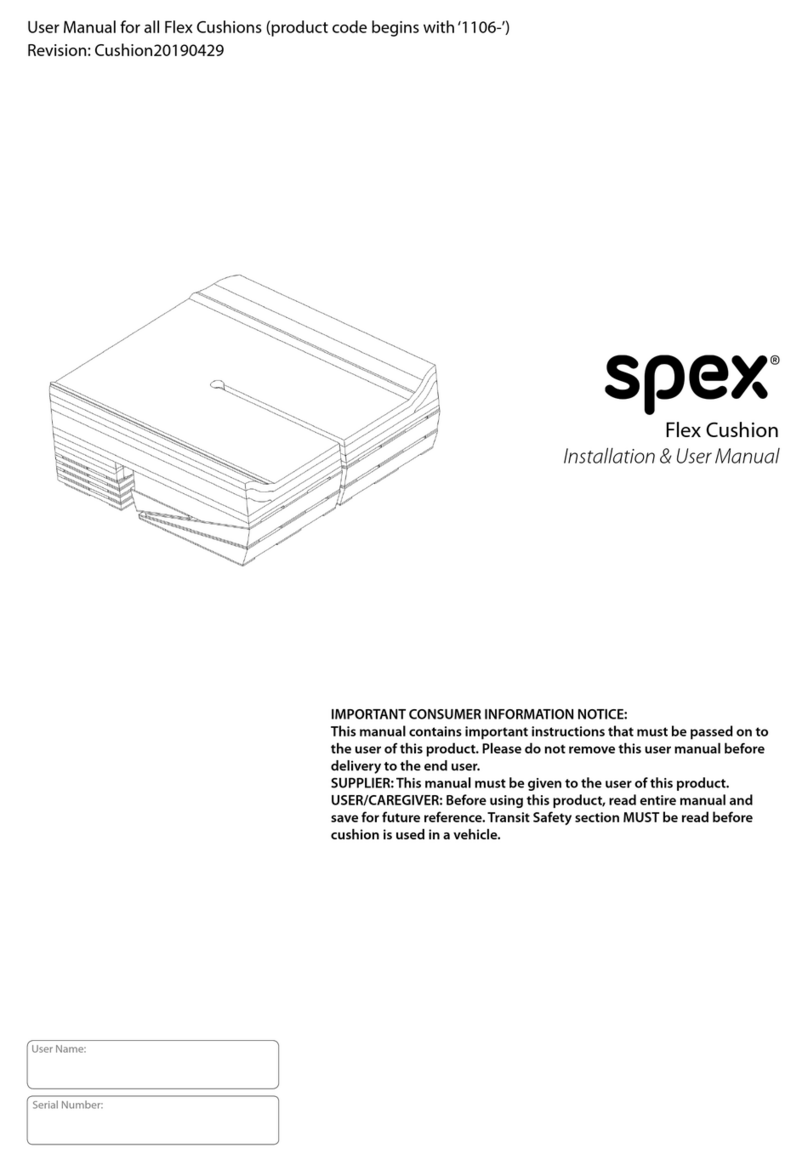
SPEX
SPEX Flex Cushion Instruction Manual
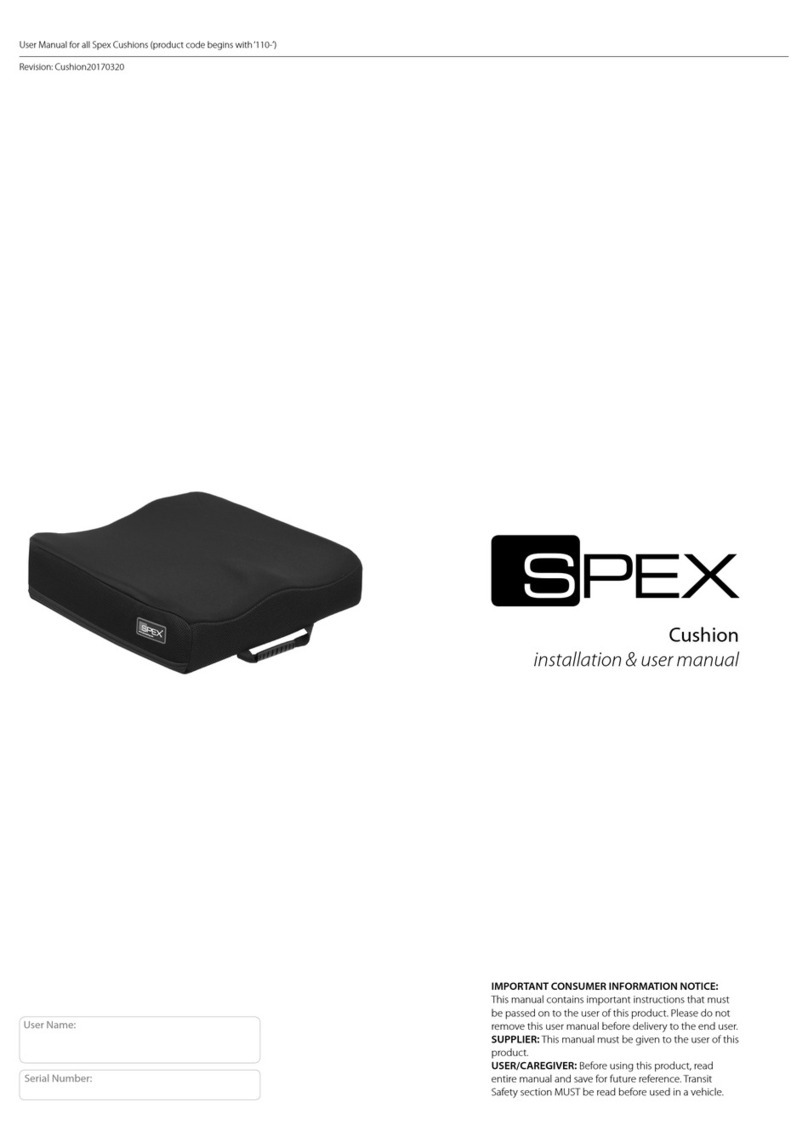
SPEX
SPEX Cushion20170320 Instruction Manual
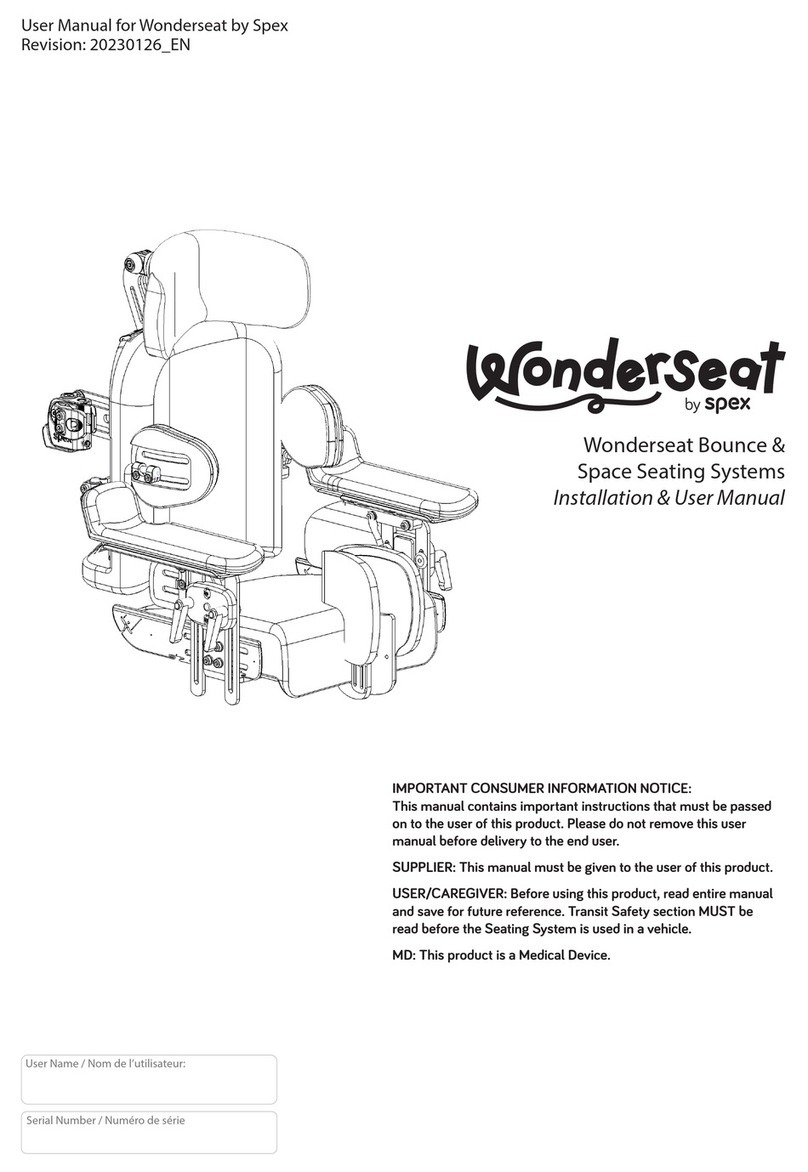
SPEX
SPEX Wonderseat Bounce Instruction Manual
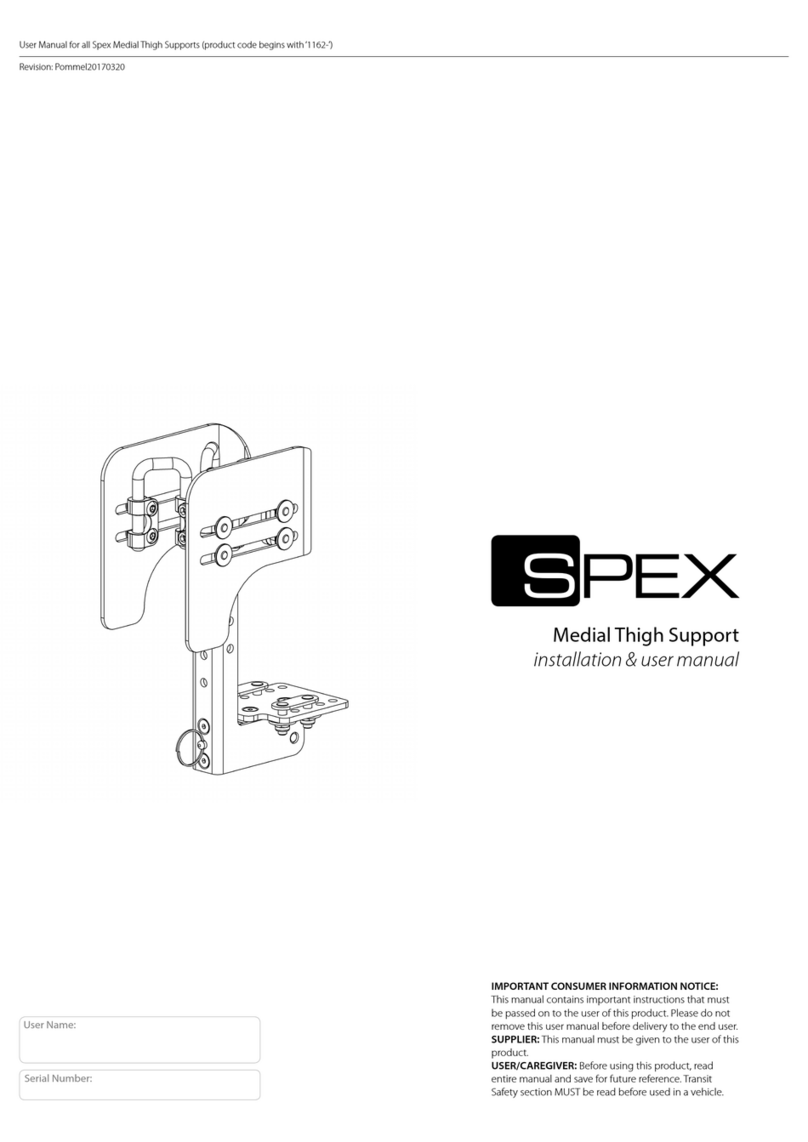
SPEX
SPEX Pommel Instruction Manual
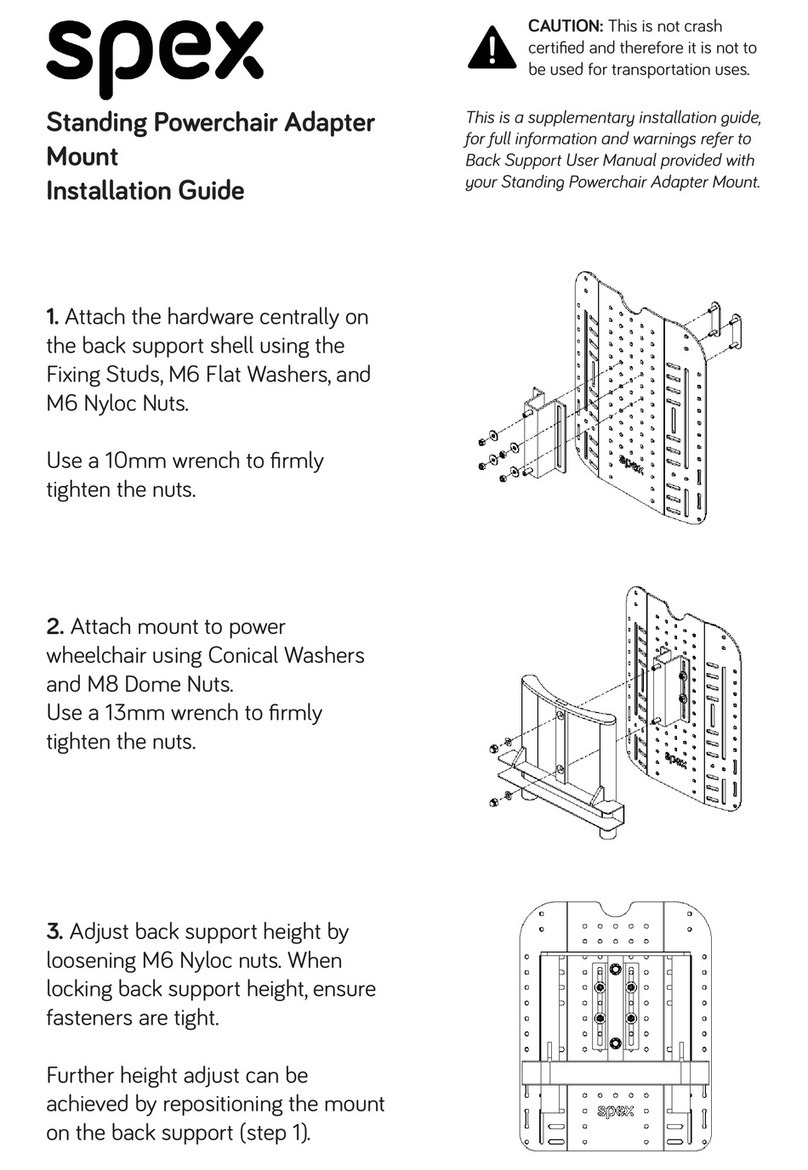
SPEX
SPEX Standing Powerchair Adapter Mount User manual
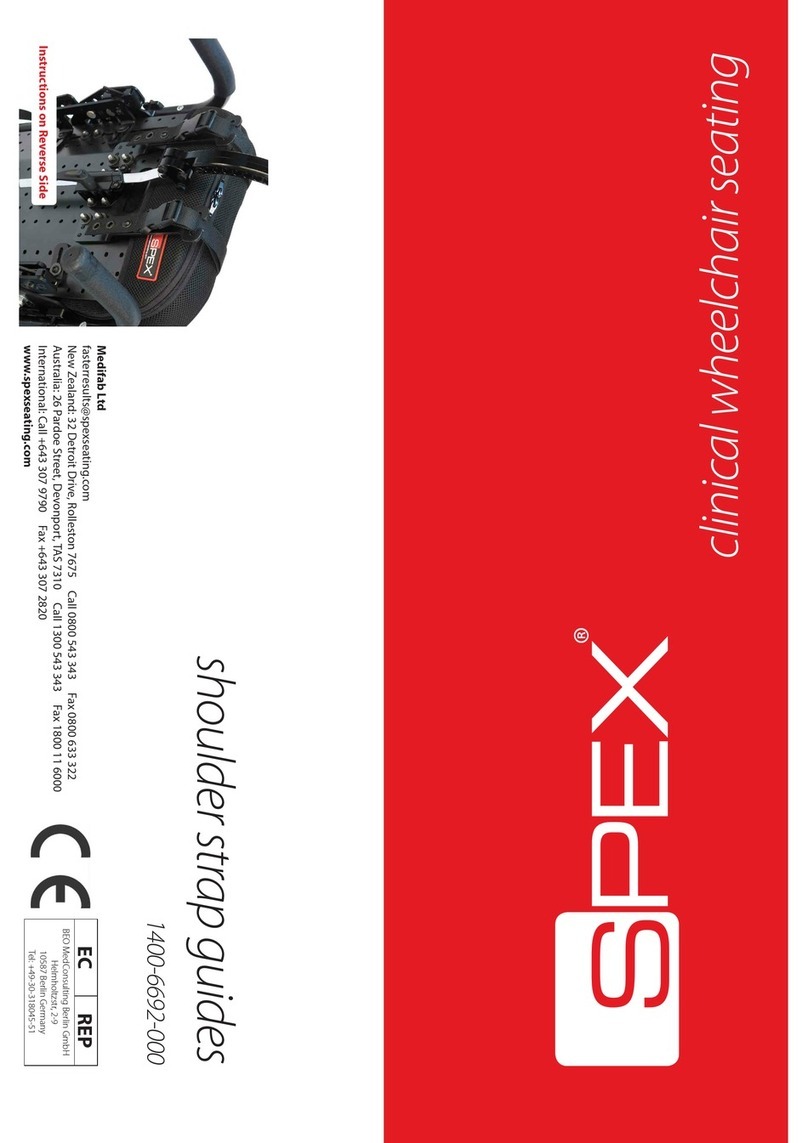
SPEX
SPEX shoulder strap guides Instruction Manual
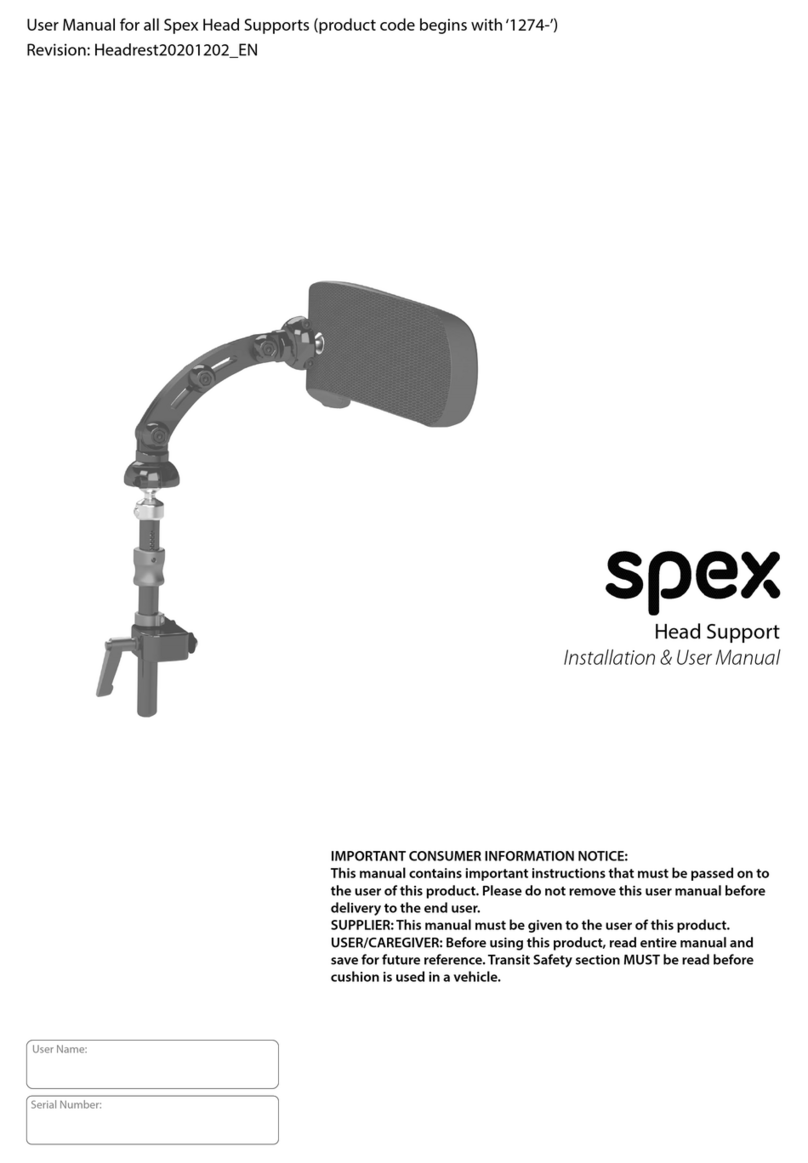
SPEX
SPEX Head Support User manual


